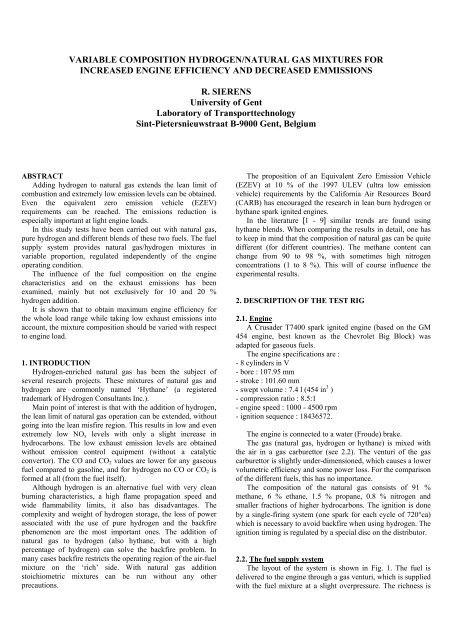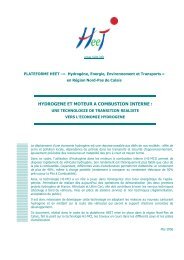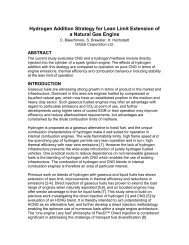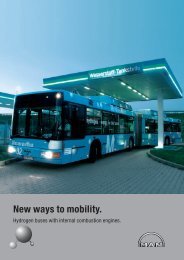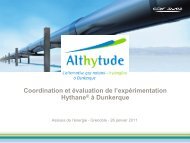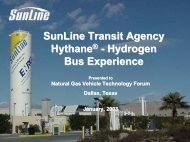VARIABLE COMPOSITION HYDROGEN/NATURAL GAS ... - Althytude
VARIABLE COMPOSITION HYDROGEN/NATURAL GAS ... - Althytude
VARIABLE COMPOSITION HYDROGEN/NATURAL GAS ... - Althytude
You also want an ePaper? Increase the reach of your titles
YUMPU automatically turns print PDFs into web optimized ePapers that Google loves.
<strong>VARIABLE</strong> <strong>COMPOSITION</strong> <strong>HYDROGEN</strong>/<strong>NATURAL</strong> <strong>GAS</strong> MIXTURES FORINCREASED ENGINE EFFICIENCY AND DECREASED EMMISSIONSR. SIERENSUniversity of GentLaboratory of TransporttechnologySint-Pietersnieuwstraat B-9000 Gent, BelgiumABSTRACTAdding hydrogen to natural gas extends the lean limit ofcombustion and extremely low emission levels can be obtained.Even the equivalent zero emission vehicle (EZEV)requirements can be reached. The emissions reduction isespecially important at light engine loads.In this study tests have been carried out with natural gas,pure hydrogen and different blends of these two fuels. The fuelsupply system provides natural gas/hydrogen mixtures invariable proportion, regulated independently of the engineoperating condition.The influence of the fuel composition on the enginecharacteristics and on the exhaust emissions has beenexamined, mainly but not exclusively for 10 and 20 %hydrogen addition.It is shown that to obtain maximum engine efficiency forthe whole load range while taking low exhaust emissions intoaccount, the mixture composition should be varied with respectto engine load.1. INTRODUCTIONHydrogen-enriched natural gas has been the subject ofseveral research projects. These mixtures of natural gas andhydrogen are commonly named ‘Hythane’ (a registeredtrademark of Hydrogen Consultants Inc.).Main point of interest is that with the addition of hydrogen,the lean limit of natural gas operation can be extended, withoutgoing into the lean misfire region. This results in low and evenextremely low NO x levels with only a slight increase inhydrocarbons. The low exhaust emission levels are obtainedwithout emission control equipment (without a catalyticconvertor). The CO and CO 2 values are lower for any gaseousfuel compared to gasoline, and for hydrogen no CO or CO 2 isformed at all (from the fuel itself).Although hydrogen is an alternative fuel with very cleanburning characteristics, a high flame propagation speed andwide flammability limits, it also has disadvantages. Thecomplexity and weight of hydrogen storage, the loss of powerassociated with the use of pure hydrogen and the backfirephenomenon are the most important ones. The addition ofnatural gas to hydrogen (also hythane, but with a highpercentage of hydrogen) can solve the backfire problem. Inmany cases backfire restricts the operating region of the air-fuelmixture on the ‘rich’ side. With natural gas additionstoichiometric mixtures can be run without any otherprecautions.The proposition of an Equivalent Zero Emission Vehicle(EZEV) at 10 % of the 1997 ULEV (ultra low emissionvehicle) requirements by the California Air Resources Board(CARB) has encouraged the research in lean burn hydrogen orhythane spark ignited engines.In the literature [1 - 9] similar trends are found usinghythane blends. When comparing the results in detail, one hasto keep in mind that the composition of natural gas can be quitedifferent (for different countries). The methane content canchange from 90 to 98 %, with sometimes high nitrogenconcentrations (1 to 8 %). This will of course influence theexperimental results.2. DESCRIPTION OF THE TEST RIG2.1. EngineA Crusader T7400 spark ignited engine (based on the GM454 engine, best known as the Chevrolet Big Block) wasadapted for gaseous fuels.The engine specifications are :- 8 cylinders in V- bore : 107.95 mm- stroke : 101.60 mm- swept volume : 7.4 l (454 in 3 )- compression ratio : 8.5:1- engine speed : 1000 - 4500 rpm- ignition sequence : 18436572.The engine is connected to a water (Froude) brake.The gas (natural gas, hydrogen or hythane) is mixed withthe air in a gas carburettor (see 2.2). The venturi of the gascarburettor is slightly under-dimensioned, which causes a lowervolumetric efficiency and some power loss. For the comparisonof the different fuels, this has no importance.The composition of the natural gas consists of 91 %methane, 6 % ethane, 1.5 % propane, 0.8 % nitrogen andsmaller fractions of higher hydrocarbons. The ignition is doneby a single-firing system (one spark for each cycle of 720°ca)which is necessary to avoid backfire when using hydrogen. Theignition timing is regulated by a special disc on the distributor.2.2. The fuel supply systemThe layout of the system is shown in Fig. 1. The fuel isdelivered to the engine through a gas venturi, which is suppliedwith the fuel mixture at a slight overpressure. The richness is
controlled using a control valve in the supply line.mixtures with up to 67 % hydrogen, due to limitations in thecontrol unit. For higher hydrogen content the mass flowcontroller has to be regulated independently of the natural gasflow or opened completely. Doing the latter results in up to 79% hydrogen. For even higher hydrogen fractions, the naturalgas flow must be throttled.Fig. 1. The fuel preparation systemBoth pure hydrogen and natural gas, as well as mixtures ofthese fuels can be used with this system. The hydrogen isstored in 9 steel bottles at a pressure of 200 bar; the natural gasis obtained from the city gas net at 30 mbar overpressure.Measurement of the fuel flow rate is made using mass flowmeters in both of the supply lines.If hythane is used, the hydrogen flow is controlled by amass flow controller (the same device is used as mass flowmeter for pure hydrogen). From the measured natural gas flowthe necessary hydrogen flow is computed and supplied as inputsignal to the mass flow controller. This results in a constanthydrogen content, independent of engine speed and load. Thehydrogen concentration is given in volume % (the term massflow meter/controller only means that the measurement isautomatically compensated for temperature and pressurechanges, the reading is in Nm 3 /h). Alternatively, hythane (orany other fuel) from a high pressure tank (200 bar) can be usedfor short runs: it contains a very limited amount of hythane andfreezing problems can occur. By putting this tank on a scalefuel consumption can be measured.The system described as above is only able to provide2.3. ApparatusThe engine is fully equipped with the usual sensors. Themeasurement/control signals are read and controlled by a PLCsystem (Programmable Logic Controller). This system monitorsengine speed, oil and coolant temperature, exhaust gastemperatures, etc. and shuts off the engine when necessary.With a Microsoft Excel worksheet all values are stored and canbe made visible on a screen.The exhaust temperatures and the exhaust gas compositioncan be measured at the exhaust of each cylinder and at the endof each bank (V engine). Two O 2 (λ)-sensors are installed atthe common exhaust pipe of each bank, which allows animmediate value of the air-fuel ratio of each bank. The λ-sensors and the exhaust temperatures give the possibility tocheck if all cylinders behave the same.The exhaust gas components are measured with thefollowing methods of measurement : CO - CO 2 - NO - NO 2(multor 610, non dispersive infra red); O 2 (servomex model OA1100, paramagnetic), HC (Signal model 3000, flameionization).A high pressure transducer (type AVL QC 32) is located inone cylinder head (mounted flush with the combustion chamberwall of cylinder 1) and is used for the calculation of the heatrelease.3. EXPERIMENTAL RESULTS AND DISCUSSIONAll measurements were made at 3800 rpm, with the throttlewide open (WOT). These conditions are chosen because at thatengine speed maximum power is reached. No other throttlepositions were used because for hythane and hydrogen the bestefficiency is achieved when regulating power throughadjustment of the air excess ratio instead of the inlet pressure(except for the very low loads in which we are not interested inthis study). This is not the case for natural gas because itscombustion becomes so slow at lean mixtures that efficiencysuffers and even misfire occurs below a certain equivalenceratio (this depends to great extent on the engine consideredhowever). Therefore the lean limit as such has not beeninvestigated here.The measurements are analysed with respect to meaneffective pressure instead of power, to make the results lessdependent on engine size and speed. For a similar reason,exhaust emissions are represented in g/kWh instead of ppm orvolume %: this way the dependence on effective engine poweris avoided. More specifically, this also avoids the effect of thedilution with air of the noxious emissions in lean mixtures.
3.1. Natural gas and hythane with 10 and 20 volume %hydrogen3.1.1. Brake mean effective pressure, fuel consumption,thermal efficiency, volumetric efficiency and ignitionadvance. In a first set of measurements a comparison is madebetween natural gas and two blends of hythane (hythane with10 and 20 volume % hydrogen respectively). Each time, sparktiming was optimised for maximum power (MBT).the same conditions is shown in Fig. 3. A λ-value between 1.1and 1.2 gives best efficiency for each of the fuels. Because ofthe very different lower heat values of combustion (forhydrogen 120 MJ/kg and for methane 50 MJ/kg), efficiencycomparisons should be made using Fig. 4. This shows that ahydrogen addition of 10 % increases efficiency moderately,whereas 20 % hydrogen gives no significant extra benefit (forthe same λ-value). This result is in agreement with Bell [9],who also found a significantly higher efficiency when adding10 % hydrogen, and no further improvement when going to 15% hydrogen.Fig. 2. The influence of the air excess factor on bmepFig. 2 shows how the air excess factor φ or air-fuel ratio λ(λ = 1/φ) influences bmep. As can be seen clearly, the differentfuel mixtures give very similar results: the only majordifference is the ability of hythane to run leaner, the more sothe higher the hydrogen content. The λ range is alsodetermined by the fuel supply system: on the rich side thesupply pressure of the natural gas is a limiting factor. For purenatural gas the lean limit gives a large reduction in enginepower (no significant benefit is to be expected from such leanrunning however : low efficiency and large hydrocarbonemissions).Fig. 4. The influence of the air excess factor on the efficiency3.1.2. Emissions. The hydrocarbon (UHC) and the NO xemissions as functions of the air excess factor are shown in Fig.5 and 6. Minimum hydrocarbon and maximum NO x emissionsare found for an air excess factor of about 1.1. This result is inagreement with the literature, and holds for any fuel (see forexample Heywood [14] for gasoline and Bell [9] for hythane).For leaner mixtures the combustion temperature is lowerbecause of the lower heat of combustion available in themixture, which reduces NO x , and for richer mixtures lessoxygen is available for the formation of NO x . The minimum inunburned hydrocarbon emissions in this range is caused by theimpossibility of complete combustion on the rich side(local/global lack of oxygen) and on the lean side the flameextinguishes further from the walls resulting in more unburnedemissions from walls and crevices. For even leaner mixturesthe flame may be unable to travel through the wholecombustion chamber and in some cases the spark may beunable to ignite the mixture at all.Fig. 3. The influence of the air excess factor on the specific fuelconsumptionThe specific fuel consumption b e (expressed in g/kWh) for
Fig. 5. The hydrocarbon emissions as a function of the airexcess factorFig. 7. The hydrocarbon emissions and bmepFor comparison at constant bmep, Fig. 7 and 8 are given.They show that ‘at the same bmep’ hydrogen addition increasesNO x and decreases unburned hydrocarbons, irrespective ofbmep level. This result seems to disagree with results from theliterature, which claim lower NO x emissions when addinghydrogen. On inspection however, it becomes clear theycompare natural gas with hythane with the latter running leanerFig. 8. The NO x emission and bmepFig. 6. The NO x emission(see for example Bell [9]), or with a reduced spark advance (seefor example Raman [8]). Both these measures have thedisadvantage of increasing unburned hydrocarbon emissions aswell as decreasing efficiency. Also, the NO x emissions can bereduced by retarding the spark from MBT for any fuel andtherefore also for pure natural gas.3.2. Hythane with 50, 67, 84 volume % hydrogen and purehydrogenIn a second set of tests a preliminary investigation wasmade on the use of higher hydrogen fractions. Due to timeconstraints (high hydrogen consumption) the ignition advancewas not optimised for each condition in this set ofmeasurements, but was kept constant at 20° before TDC,except for pure hydrogen where the optimal spark advance wasused (which varies from 12° at λ = 1.5 to 22° at λ = 3.5).For pure hydrogen, the engine could function reliably(without backfire) for λ ≥ 1.5. Hythane with less than 79 %hydrogen never causes backfire nor knock in this engine,whatever the richness. During the measurements with 84 %hydrogen knock (without backfire) occurred for λ = 1.06. Thissuggests that a hydrogen content of 80 % or less guaranteessafe operation of the engine, whatever the air excess factor.
Fig. 9. The bmep for high hydrogen concentrationsIn Fig. 9 the bmep achieved by pure hydrogen and hythanewith 50, 67, and 84% hydrogen is shown. Remarkably allhythane mixtures give a very comparable output for λ between1 and 1.3. This is in agreement with the results presented byRaman [8], who compared pure natural gas with hythane (30 %hydrogen) and found the same bmep at λ = 1.3 and only 2 %bmep loss at stoichiometry with hythane. The reason for thisbehaviour is that increasing the hydrogen content increasesflame speed (increasing bmep) but decreases the volumetricenergy content (for λ < 1.43) (decreasing bmep) (Raman [8]).In the λ region considered both effects compensate each otherlargely. For λ > 1.43 the volumetric energy content as well asthe flame speed increase with higher hydrogen contents, whichFig. 10. The efficiency for high hydrogen concentrationscauses higher bmep for those mixtures. At these air excessratios the bmep drops significantly though.For strongly lean mixtures pure hydrogen gives the highestoutput, as it is the only fuel capable of fast combustion at theseconditions.4. THE LOW EMISSION POTENTIAL OF HYTHANEMost - if not all - of the literature about the use of hythaneconcerns the possibility to achieve extremely low emissions.We will now investigate how this can be done.Assuming that an ultra low emission vehicle (ULEV) with afuel consumption equivalent to 10 l gasoline per 100 km (fueldensity of 0.75 kg/l) during the test cycle has to be designed,the emissions performance of the engine can be estimated. Ifwe take the average engine efficiency equal to 20 %, the ULEVlimits (1.7 g CO per mile, 0.04 g NMOG per mile and 0.2 gNO x per mile) convert to an average engine emission level ofno more than 15 g CO per kWh, 0.35 g NMOG per kWh and1.75 g NO x per kWh. These average engine emission levels areroughly calculated as follows : 10 l/100 km x 0.75 kg/l x 0.20(η e ) x 43.5 10 6 J/kg (H u ).(3600 10 3 ) -1 kWh/J gives 0.181kWh/km. For CO one finds 1.7 g/mile x 1.609 mile/km / 0.181kWh/km ≅ 15 g/kWh.Looking at the emission graphs, it seems that thehydrocarbon emissions are always too high. However, becausethe unburned hydrocarbons (UHC’s) originate mainly from thefuel and more specifically from the natural gas fraction of thefuel, they are mostly methane. Because the ULEV limitsconcern non methane organic gases (NMOG; methane is notrelevant with respect to the formation of tropospheric ozone),this improves the chances to comply with the limits.Unfortunately, the exhaust gas analysis equipment available forthe experiments described here, didn’t allow the measurementof NMOG directly.The CO emissions from the tested engine are very low, as isthe case for any gaseous fuel, and therefore doesn’t causemayor problems when trying to comply with the limits.As can be seen from Fig. 6, the NO x emissions are only lowenough for very lean hydrogen and lean hythane mixtures. Inthe case of hythane, the higher the hydrogen fraction, the leanerthe engine has to run and the lower the achievable bmep. Atthese conditions the engine produces a lot of UHC (see Fig. 5),which makes it extremely unlikely that the NMOG limit can beattained without exhaust gas treatment. The use of purehydrogen gives no problem with NMOG, since only anegligible amount of UHC is emitted (no hydrocarbons in thefuel).For lean mixtures, it is however possible to reduce CO andUHC (and therefore NMOG) emissions by using an oxidationcatalyst. If we take into account that the NMOG fraction isreduced more strongly than the methane fraction, it is veryprobable that in this way the NMOG limits can be fulfilled.Therefore the following strategy to run the engine can beproposed.• At low loads, pure hydrogen is used (λ > 2), limiting NO xand eliminating NMOG and CO emissions.• At intermediate loads, hythane is used in such a way thatNO x remains low. The oxidation catalyst reduces CO andNMOG emissions to acceptable levels.• At full load (nearly) pure natural gas is used, providing highmaximum bmep.
Although this means high emissions at full load conditions,this is not a major concern with respect to the legal limits sincethese conditions don’t occur in the test cycles used to measureemissions. Also, during everyday vehicle use the engine ismainly operated at part load reducing the need to optimiseemissions at full load. If low emissions are to be reached at alloperating conditions, a three way catalyst may be used with λ =1 operation at high loads. This necessitates the use of a throttleto regulate power in the high load region and is unpracticalwithout a drive by wire system. A less complicated solutionwould be to make the high load region simply unavailable forthe driver (not an acceptable solution to the end user).Such a system has the following advantages.• High efficiency : WOT is used at all but the lowest loads,avoiding throttling losses. Fig. 4 and 10 show that nearoptimal efficiency is reached. Spark advance is set at MBT.• Low emissions.• Low knock sensitivity : at high loads pure natural gas with ahigh ON is used; at lower loads lean running avoids knock.This opens the possibility for high compression ratios,which increase efficiency.• Backfire is avoided : since hydrogen is not used at λ < 1.5,backfire can be avoided without taking any specialprecautions.The disadvantages are :• weight and volume : two fuels must be stored.• complexity and cost : a mixing system is necessary tocontrol the hydrogen/natural gas ratio.5. CONCLUSIONSA fuel supply system was designed and implemented thatprovides the engine with a hydrogen/natural gas mixture in avariable proportion. The composition of this mixture can be setindependently of engine operation. For future practicalapplications, minimal modifications should allow this variablemixture composition with respect to engine load for maximumefficiency and minimal pollution.For hythane with low hydrogen content (up to 20 %) alimited improvement in emissions can be obtained. Because ofthe conflicting requirements for low hydrocarbons and lowNO x extremely low emissions are not possible without exhaustaftertreatment : to reduce hydrocarbon emissions λ must be lessthan 1.3, while for low NO x λ must be at least 1.5.For lower bmep, high efficiency can be achieved byincreasing the hydrogen content and thus avoiding throttlinglosses. At the same time unburned hydrocarbon emissions areminimized, while (for lean mixtures) NO x emissions staylimited. This means that for optimal results the composition ofthe fuel should depend on load.REFERENCES[1] Hoekstra R.L., Collier K., Mulligan N. and Chew L.,Experimental study of a clean burning vehicle fuel.Int. J. Hydrogen Energy, Vol. 20, nr 9, pp. 737-745, 1995.[2] Hoekstra R.L., Collier K. and Mulligan N., Demonstration ofhydrogen mixed gas vehicles.10 th World Hydrogen Energy Conference, Cocoa Beach,Proceedings, Vol. 3, 1994, pp. 1781-1796.[3] Hoekstra R.L., Van Blarigan P. and Mulligan N., NO xemissions and efficiency of hydrogen, natural gas andhydrogen/natural gas blended fuels.SAE paper 961103.[4] Swain M.R., Yusuf M., Dülger Z. and Swain M.N., Theeffects of hydrogen addition on natural gas engine operation.SAE paper 932775.[5] Yusuf M., Swain M.R., Swain M.N. and Dülger Z., Anapproach to lean burn natural gas fuelled engine throughhydrogen addition.30 th ISATA conference, paper 97EL081, Florence, June 1997.[6] Larsen J.F. and Wallace J.S., Comparison of emissions andefficiency of a turbocharged lean-burn natural gas and hythanefuelledengine.Transactions of the ASME, Vol. 119, Jan. 1997, pp. 218-226.[7] Cattelan A.I. and Wallace J.S., Hythane and CNG fuelledengine exhaust emission and engine efficiency comparison.10 th World Hydrogen Energy Conference, Cocoa Beach,Proceedings, Vol. 3, 1994, pp. 1761-1770.[8] Raman V., Hansel J., Fulton J., Lynch F. and Bruderly D.,Hythane - an ultra clean transportation fuel.10 th World Hydrogen Energy Conference, Cocoa Beach,Proceedings, Vol. 3, 1994, pp. 1797-1806.[9]Bell S.R. and Gupta M., Extension of the lean operating limitfor natural gas fuelling of a spark ignited engine using hydrogenblending.Combustion Science and Technology, 1997, Vol. 123, pp. 23-48.[10] Dhooge D. and Pussemier B., Ombouwen van een GMmotortot een waterstofmotor, (Converting a GM-engine into aHydrogen Engine).End of year thesis, Laboratory for Machines, University of Gent,1997.[11]Sierens R., Comparative tests on a SI engine fuelled withnatural gas or hydrogen.ASME Winter meeting Houston 93, ASME/ICE EngineSymposium at the Energy-Sources Technology Conference,paper no. 93 ICE-15.[12] Milton B.E. and Keck J.C., Laminar burning velocities instoichiometric hydrogen and hydrogen-hydrocarbon gasmixtures.[13]Karim G.A., Hydrogen as an additive to methane for engineapplications.11 th World Hydrogen Energy Conference, Stuttgart, Proceedings,Vol. 2, 1996, pp. 1921-1926.[14] Heywood J., Internal Combustion Engine Fundamentals.McGraw-Hill, 1988.


